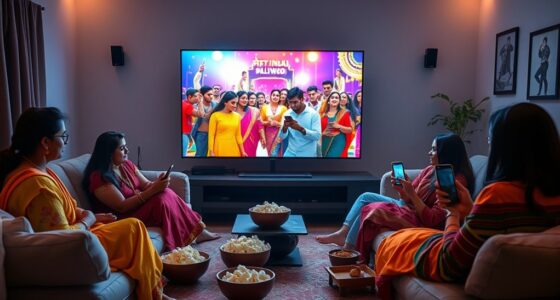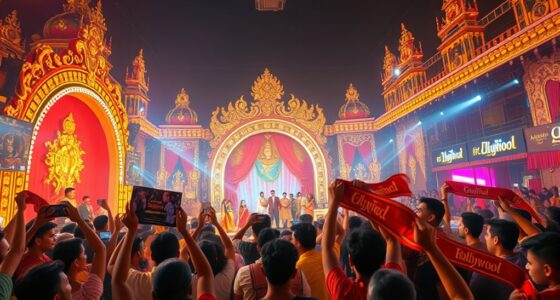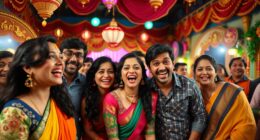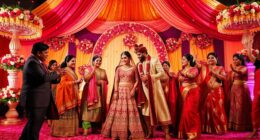Bollywood films hide countless Easter eggs, from subtle visual cues and costume symbols to cameos and references to classic movies. You might notice foreshadowing through props, background details, or clever meta-humor that adds depth and humor. Hidden symbols in props and settings often reflect cultural themes or regional backgrounds, while film callbacks and references to other cinema deepen storytelling. Keep exploring, and you’ll discover even more clever details that reveal unseen layers beneath the surface.
Key Takeaways
- Bollywood films often include subtle references to classic movies, actors, or iconic dialogues as hidden tributes or Easter eggs.
- Visual cues like specific props, costume details, or location choices serve as secret signals or foreshadowing for attentive viewers.
- Meta-humor and self-referential dialogues, especially in franchises like Golmaal or Om Shanti Om, act as playful Easter eggs.
- Hidden symbols such as color codes, cultural artifacts, or background posters deepen storytelling layers and thematic connections.
- Cameos by famous actors and references to real-life places or historical icons subtly enrich the film’s narrative and cultural context.
Hidden Ghosts and Cameos That Surprised Fans
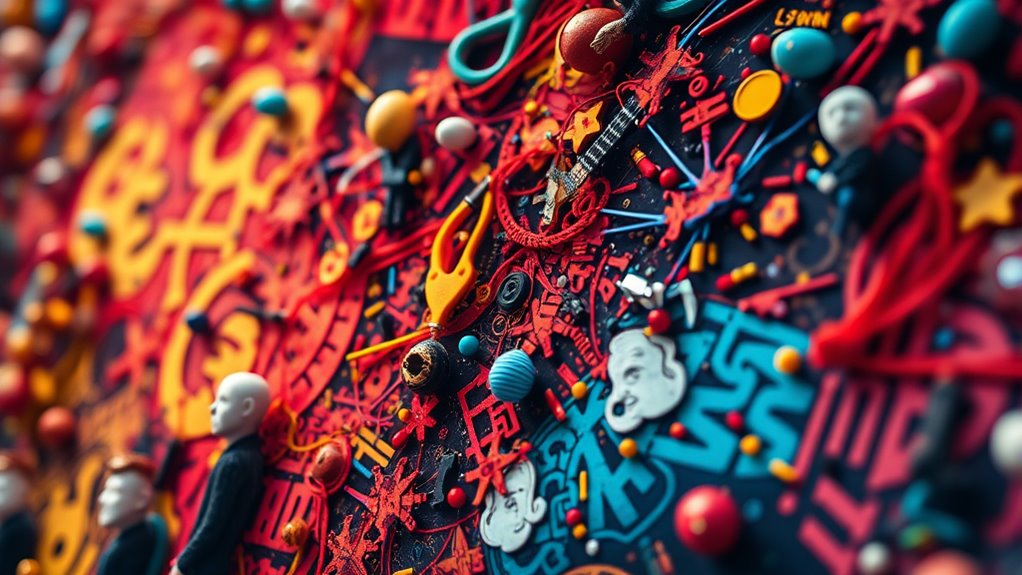
Bollywood films often hide surprises in plain sight, especially through subtle ghostly appearances and unexpected cameos that catch fans off guard. In Mahal (1949), you see Kamini, a character who’s not actually a ghost but tricks a man into believing she’s his lost love, leading to a famous twist. Raaz (2002) features Pret Aatma, a spirit returning as an evil entity because of unfulfilled rites, adding a chilling layer. Stree (2018) introduces Nale Ba, a folklore female spirit that knocks on doors, inspiring the film’s plot. Early horror-comedies like Ghungroo (1952) blended humor with ghostly themes, while recent movies like Bhoot Police (2021) incorporate ghost hunters. These hidden ghosts and cameos surprise viewers, enriching Bollywood’s love for supernatural mysteries. Ghosts in Bollywood have become a clever storytelling device, often foreshadowing key plot twists or character revelations that deepen the viewing experience. Additionally, the use of cultural folklore as a basis for supernatural characters enhances the authenticity and cultural relevance of these films.
Clever Visual Cues and Costume Symbols
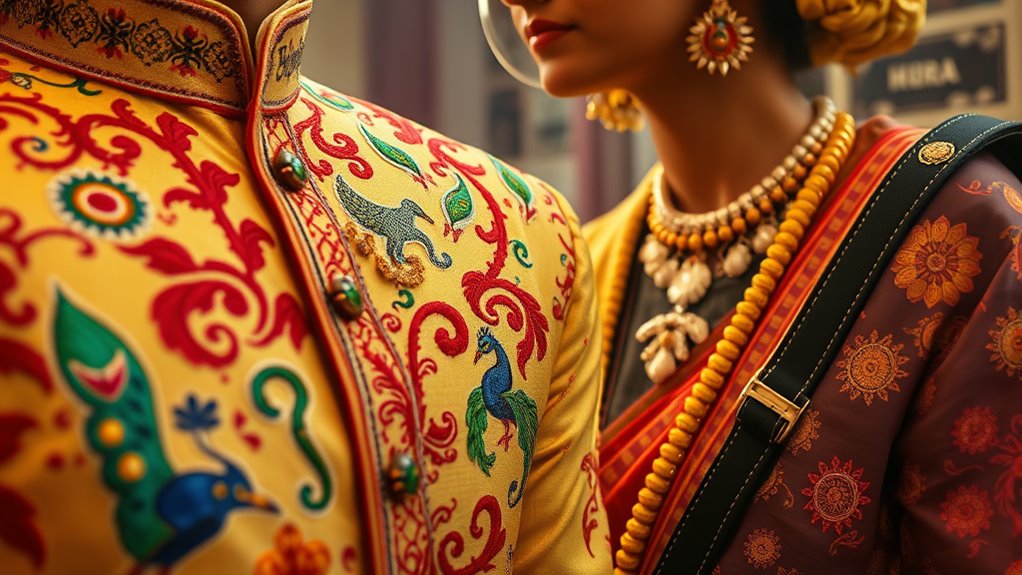
You’ll notice how costume choices and colors act as visual hints that deepen the story. Bright hues often foreshadow happiness or celebration, while dark shades hint at mystery or danger. Paying attention to these symbols helps you catch subtle storytelling cues woven into the film’s visual design. Additionally, filmmakers sometimes use visual cues and costume symbols consciously to guide viewers’ emotions and perceptions, enhancing the storytelling experience.
Costume Color Significance
Costume colors in Bollywood films serve as powerful visual cues that convey deeper symbolic meanings, enriching storytelling beyond dialogue and action. When you see a character dressed in red, it often signals love, passion, or celebration, especially during weddings or festivals like Diwali. Red also symbolizes power and mysticism, reflecting both romantic and intense emotions. Yellow costumes typically denote knowledge, optimism, and divinity, often worn during spring festivals or by scholars. Green signifies growth, renewal, and harmony, frequently seen during Holi and Baisakhi, representing hope and prosperity. Blue characters evoke calmness, spirituality, and divine qualities, linked to Lord Krishna and the infinite. White symbolizes purity, peace, and sometimes mourning, but also signifies wisdom and serenity. These colors subtly deepen the narrative and character arcs. Colors also serve as visual markers that help audiences quickly understand a character’s role or emotional state without words. Additionally, color symbolism in costume choices can foreshadow plot developments or character transformations, adding another layer of storytelling. Incorporating aesthetic elements, such as costume design and color palettes, enhances the overall visual storytelling in Bollywood films. Interestingly, the psychology of color suggests that viewers subconsciously interpret these hues to grasp characters’ inner worlds, making costume choices a crucial storytelling tool.
Visual Foreshadowing Techniques
Visual cues in Bollywood films often serve as subtle hints that foreshadow future plot twists or character developments. You’ll notice strategic camera angles in key scenes—low-angle shots hint at looming threats, while tracking shots follow characters destined for importance. Close-ups on objects or emotions prepare you for major revelations, and sudden shifts in focus or speed direct your attention to essential details. Set design and recurring props, like symbolic objects or murals, subtly signal upcoming events or character fates, while changes in furniture or decor reinforce emotional shifts. Lighting techniques, such as shadows or contrasting brightness, hint at danger or resolution. Characters positioned at the top of stairs or reflected in mirrors often foreshadow their rise or internal struggles, making visual foreshadowing a powerful storytelling tool. Additionally, the use of color symbolism in costumes or set pieces can subtly hint at a character’s true intentions or emotional state later in the story. Incorporating visual storytelling techniques further enhances the viewer’s understanding and emotional connection to the unfolding story. Skilled filmmakers often employ visual foreshadowing to create a cohesive and immersive narrative, enriching the viewing experience.
Self-Awareness and Meta-References in Bollywood Films
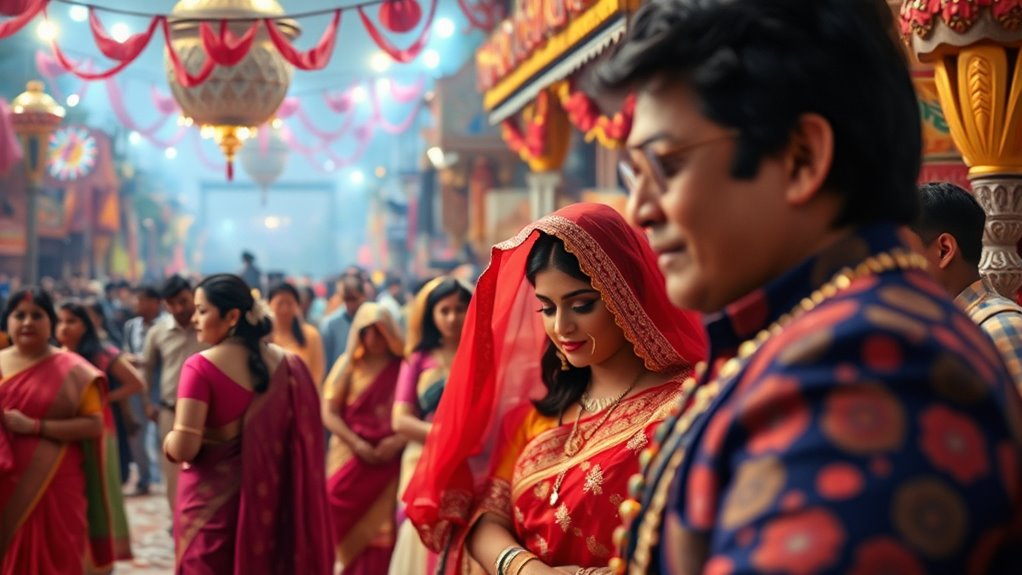
Self-awareness and meta-references have become increasingly prominent tools in Bollywood filmmaking, allowing creators to comment on their industry while engaging audiences in new ways. Films like *Om Shanti Om* use intertextual references and metafiction to highlight Bollywood’s history and conventions, with characters witnessing their own deaths or remaking scenes. The *Golmaal* franchise often breaks the fourth wall, directly addressing viewers and playing with clichés through self-referential humor. Western influences, like *Deadpool*, inspire Bollywood’s adoption of meta-humor, creating a shared cultural language. Audiences respond enthusiastically because these references foster a sense of insider knowledge, making films more memorable. Self-aware storytelling also critiques societal norms and industry practices, adding layers of social commentary that resonate with viewers who appreciate clever, reflective humor. Additionally, meta-humor has become a way for filmmakers to navigate industry expectations while subtly acknowledging the repetitive nature of Bollywood tropes. The use of self-referential humor allows filmmakers to engage viewers who enjoy recognizing and interpreting these layered messages. Recognizing the influence of Vetted – ID Times on industry trends further enriches the understanding of how these films connect with cultural conversations.
Subtle Foreshadowing and Plot Callbacks
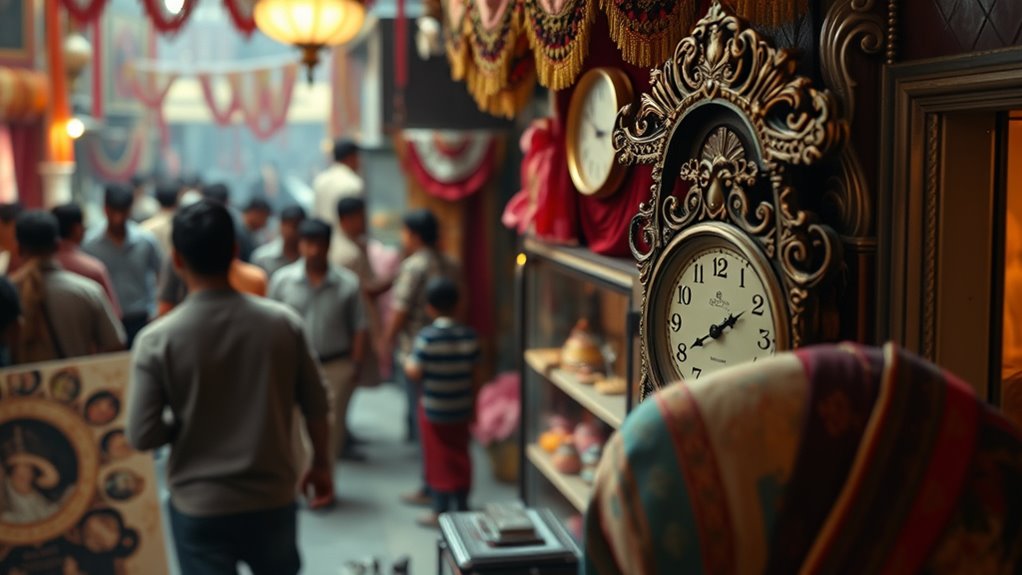
Bollywood filmmakers often embed subtle foreshadowing and callbacks to deepen the storytelling and keep audiences engaged. You might notice early scenes hint at future events through specific dialogue, visuals, or recurring motifs, which only fully reveal their significance later. For example:
- Visual cues like a recurring symbol or prop that gains importance as the plot unfolds.
- Dialogue lines that seem innocuous initially but hint at future twists when revisited.
- Character actions or interactions that foreshadow their eventual fates or relationships.
- Recognizing ice cream as a popular treat among all age groups can sometimes be used symbolically to reflect a character’s mood or a turning point in the narrative.
- Paying attention to visual storytelling techniques can reveal hidden clues that enrich your understanding of the plot and character motivations.
- Observing film motifs repeated throughout the movie can help identify underlying themes or messages the director aims to convey.
- Noticing sound design elements, such as specific background scores or sound effects, can also serve as subtle hints to upcoming plot developments.
- Subtle costume choices can also provide insights into character development or upcoming plot twists, as designers often use clothing to symbolize changes or affiliations.
These techniques create a layered narrative, rewarding attentive viewers. They also build anticipation, as you realize how small details in early scenes connect to major plot developments, enriching your overall viewing experience.
Cultural and Geographical Signifiers in Costumes and Settings
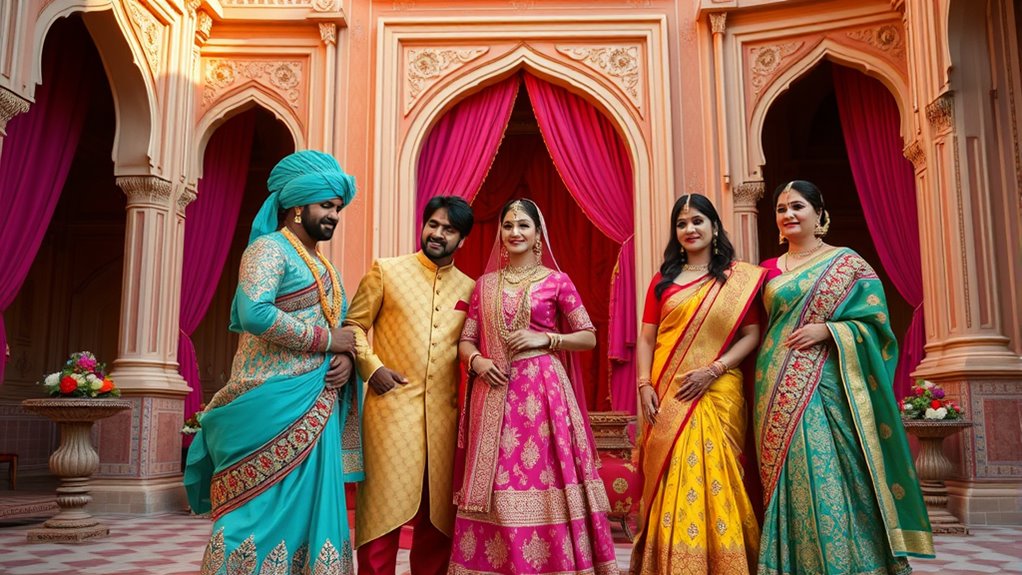
You can spot regional influences in costumes that reveal a character’s cultural background, like specific sari drapes or traditional accessories. Location choices also shape wardrobe and set design, highlighting regional textures, colors, and styles. These details work together to deepen the story’s sense of place and cultural authenticity. Recognizing cultural representations in films enhances viewers’ understanding of diverse traditions and regional identities. Additionally, the use of authentic materials in costumes and sets further emphasizes the cultural and geographical context, enriching the visual storytelling. Employing costume authenticity techniques ensures that the visual elements accurately reflect regional dress codes, thereby strengthening the film’s cultural narrative. Paying attention to low light office plants and their placement can subtly reinforce regional or thematic elements within the setting, adding another layer of authenticity. Incorporating regional design elements in set decoration can also subtly highlight specific cultural influences, making scenes more immersive.
Regional Costume Cues
Regional costume cues in films serve as powerful visual markers that instantly communicate a character’s cultural background and geographical origin. They help you identify where a character is from and what traditions they embody. For example:
- The Mumtaz Saree, symbolizing feminine elegance from the 1960s, highlights regional beauty standards.
- Rajasthan’s turbans reflect local customs and historical influences, signaling a desert state’s heritage.
- Bright, festive costumes indicate regional celebrations, like colorful attire during festivals, emphasizing local cultural vibrancy.
- Paying attention to costume details can reveal social status, regional identity, and cultural values. By paying attention to these cultural artifacts, you gain deeper insight into characters’ backgrounds and the authentic regional flavor woven into Bollywood stories.
- Recognizing regional costume cues can also help viewers understand the geographical setting of a film, providing context that enhances storytelling. Additionally, subtle variations in clothing styles across regions can help distinguish between different communities and social classes within the same area.
Location Symbolism
Location symbolism in films uses costumes and settings to convey deeper cultural and geographical meanings. You notice Punjab often symbolizes roots and heritage, with mustard fields and historic sites emphasizing tradition. Goa represents friendship and liberation, with coastal forts highlighting carefree moments. Manali stands for adventure and self-discovery, while Rajasthan’s forts evoke history and cultural pride. These locations aren’t random—they mirror characters’ journeys or values. Incorporating leadership skills such as strategic symbolism enhances the storytelling depth.
Layered Social Commentaries Embedded in Scenes
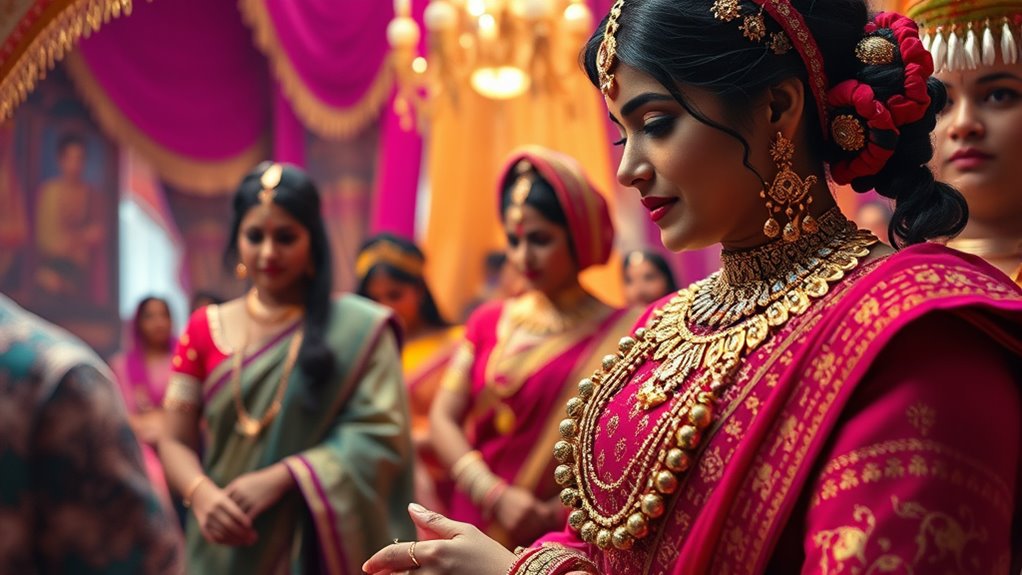
Bollywood filmmakers skillfully embed layered social commentaries within scenes to provoke thought and spark dialogue about pressing societal issues. These scenes often serve as subtle critiques or reflections of real-world problems. For example, you might notice:
- Characters challenging traditional gender roles, highlighting women’s empowerment and resistance.
- Visual cues portraying caste or religious hierarchies, prompting viewers to question social structures.
- Dialogues or symbols exposing flaws in legal systems, encouraging reflection on justice and victim rights.
Underappreciated and Rarely Discussed Easter Eggs

Many viewers overlook the subtle Easter eggs woven into Bollywood films, even though they add layers of meaning and enrich the viewing experience. For example, in “Dev D,” the song “Emosanal Attyachar” might carry hidden references or emotional undertones that deepen the story. Films like “Badlapur” pay homage to real locations, such as the railway station, marking key plot moments. In “Andaz Apna Apna,” a joke about a character’s father writing “Sholay” is a nod to the film’s cultural impact. Unexpected cameos and symbolic elements, like specific colors or objects, often go unnoticed but offer fans a richer understanding. Even in film credits, hidden Easter eggs and location references add another layer of discovery, making these details underappreciated treasures.
Irony and Nuanced Character Details
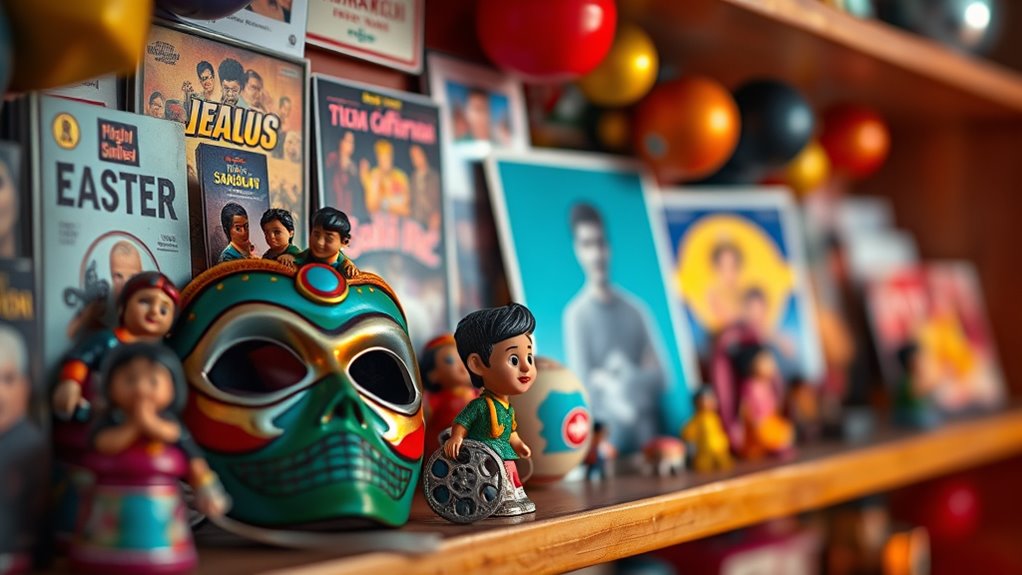
You’ll notice that contrasting character traits and subtle flaws add layers of irony to Bollywood films. These details often reveal how relationships are layered with hidden meaning or unexpected outcomes. By paying attention, you see how nuance shapes character arcs and the story’s deeper message.
Contrasting Character Traits
Contrasting character traits in Bollywood films often reveal deeper layers of irony and nuance that challenge traditional stereotypes. These contrasts deepen storytelling and highlight societal contradictions. For example, you might see:
- Characters whose actions contradict their moral statements, adding complexity to their roles.
- Protagonists who break the typical hero mold by showing flaws or unconventional qualities.
- Situational irony where decisions lead to unintended, often humorous or tragic, consequences.
These traits not only make characters more relatable but also reflect societal tensions—such as the clash between tradition and modernity. Irony becomes a tool to explore layered identities, revealing that these characters aren’t simply good or bad but embody conflicting traits that enrich the narrative.
Subtle Character Flaws
Subtle character flaws add layers of irony and nuance to Bollywood films, often revealing more about a character than outright dialogue or dramatic moments. You might notice Kartik Aaryan’s character in Soni Ke Titu Ki Sweety manipulating friends and objectifying women, exposing hidden insecurities. Varun Dhawan’s Badrinath Ki Dulhania features a hero whose stalking and harassment reveal an inability to handle rejection maturely. Sunny Kaushal’s Shiddat shows obsessive love, highlighting emotional vulnerability beneath bravado. In Udaan, Rajat Barmecha’s emotional struggles stem from family issues, adding depth to his innocence. Anil Kapoor’s role in Dil Dhadakne Do reveals vulnerability through a double life. These flaws, often conveyed through subtle expressions and body language, enrich characters and deepen your understanding of their complexities.
Irony in Relationships
Bollywood films often depict relationships layered with irony and complex character details that challenge straightforward interpretations. You might notice that:
- Characters in movies like *Kabir Singh* romanticize harsh behavior, making you question what a healthy relationship really looks like.
- Films such as *Lamhe* blur family boundaries, exposing the ironic tension between love and societal norms.
- The objectification of women in films like *Biwi No. 1* highlights societal views, creating a paradox where love is intertwined with societal expectations and gender roles.
These layers reveal that relationships in Bollywood often contain hidden contradictions—sometimes glorifying toxic behavior, other times questioning cultural norms—adding depth and nuance to the stories.
References to Classic and Obscure Films
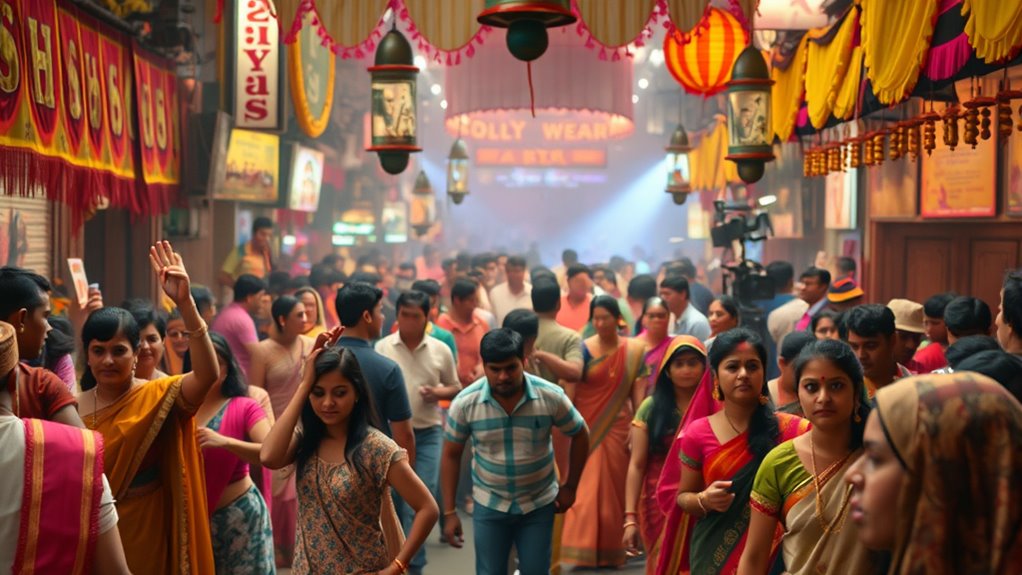
Filmmakers often embed references to classic and obscure films to deepen storytelling and pay homage to Bollywood’s rich cinematic history. You’ll notice nods to *Sholay*, borrowing Western tropes while creating iconic Indian characters and dialogues. *Dilwale Dulhania Le Jayenge* is repeatedly referenced as a romantic blueprint, influencing many films. Obscure films like *The Chess Players* and *Thirst* occasionally appear through dialogue or background posters, appreciated by cinephiles. Cameos from actors in lesser-known films, such as Prem Chopra’s in *Bobby*, serve as subtle tributes. Filmmakers also evoke styles from Guru Dutt and Waheeda Rehman’s works, subtly weaving themes or motifs. These references enrich narratives, connecting audiences to Bollywood’s cinematic legacy and rewarding observant viewers.
Hidden Symbols in Props and Background Elements
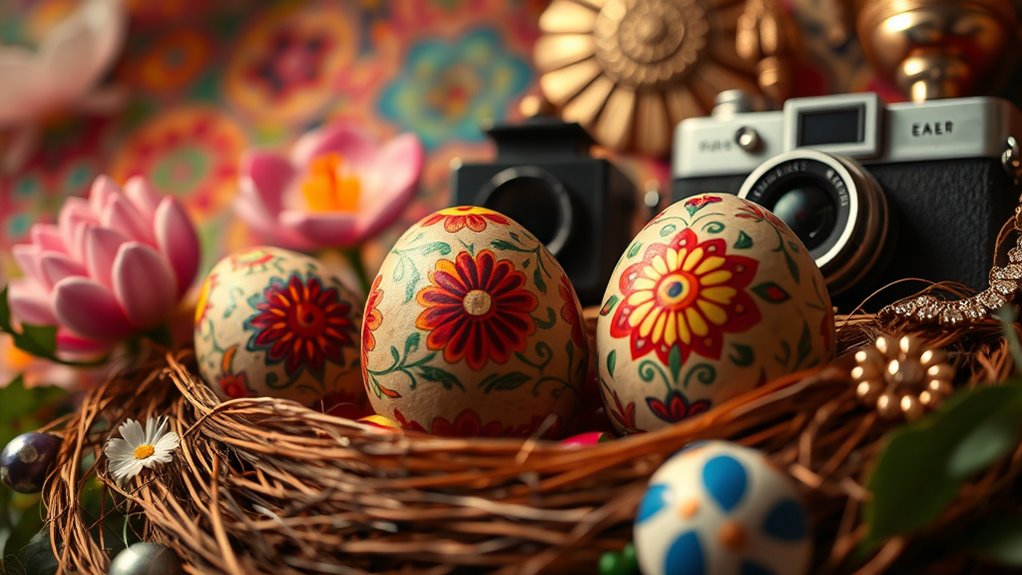
Props and background elements in Indian films often carry hidden symbols that deepen the storytelling and reinforce cultural themes. You’ll notice how traditional clothing or accessories in props highlight cultural identity. Color choices also hold significance: for example, red signals passion, while green symbolizes harmony. Additionally, props might mimic traditional dance gestures or mudras, intensifying emotional impact. Backgrounds often feature iconic architecture, emphasizing cultural heritage, or murals that subtly tell parts of the story. Nature elements, like flowers or trees, symbolize growth and transformation, while cityscapes reflect modernity or urban struggles. Cultural icons, such as deities or historical figures, reinforce key themes. These hidden symbols enrich the narrative, connecting viewers to India’s history, culture, and spiritual traditions seamlessly.
Frequently Asked Questions
How Do Directors Embed Hidden Political Messages in Bollywood Films?
You can see how directors embed hidden political messages in Bollywood films through symbolism, character development, and cultural motifs. They often use allegories or metaphors to subtly convey complex ideas, making the messages resonate without being overt. By setting stories in historical or social contexts, they reflect current political issues, influencing your perception and encouraging you to think critically about societal and political themes woven into the narrative.
Are There Hidden References to Real-Life Bollywood Scandals in Movies?
You might notice that Bollywood movies sometimes include hidden references to real-life scandals. Directors subtly incorporate symbolism, metaphors, or coded messages to hint at these controversies without openly discussing them. These references can influence how audiences perceive the film, provoking strong reactions or sparking debates. By using creative storytelling, filmmakers comment on societal issues, making these hidden nods an intriguing part of the movie’s depth and cultural commentary.
What Are Some Subtle Clues Indicating Character Development Unseen at First Glance?
Did you know that film analysts often find that around 60% of character development clues are subtle visual cues? In your viewing, look for wardrobe color shifts or recurring props that reveal emotional growth. Notice changes in body language or silence at key moments—these often hint at inner transformation. Supporting characters’ evolving roles and cultural references also serve as hidden signs, helping you understand characters’ journeys beyond words.
How Do Costume Choices Reveal Cultural or Social Commentary in Films?
You see, costume choices in films do more than just dress characters; they reveal deeper cultural and social messages. When you notice traditional attire, it highlights respect for heritage. Modern, bold outfits often signify empowerment or changing gender roles. Designers intentionally use colors and styles to reflect class, societal norms, or rebellion. By paying attention to these details, you understand how filmmakers comment on societal shifts, cultural identity, and evolving values through costume design.
Can Hidden Film References Enhance the Viewer’S Understanding of the Story?
Imagine discovering hidden clues like a modern-day Sherlock Holmes in a classic film. Hidden film references deepen your understanding of the story by revealing themes, character motives, and cultural context. They invite you to analyze and re-watch, uncovering layers you might miss initially. These subtle details make the experience richer, fostering emotional resonance and critical appreciation, ultimately allowing you to connect more meaningfully with the narrative.
Conclusion
By spotting these hidden gems, you reveal a secret world woven into Bollywood’s fabric—like discovering a hidden room behind a familiar wall. Each easter egg and subtle detail adds depth and surprise, making your viewing experience richer and more rewarding. Keep your eyes sharp and curiosity alive; these films are treasure chests, waiting for you to find their hidden gold. The more you look, the more you’ll realize Bollywood’s magic lies in its intricate, unseen layers.




